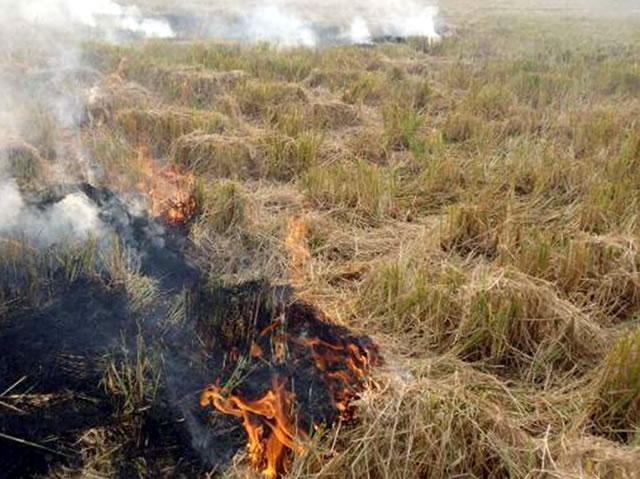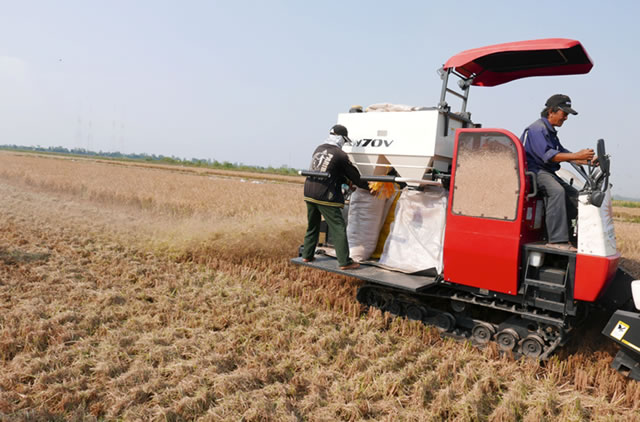In-field rice straw management
Open-field burning
 Figure 1. Rice straw burning in an open field in Vietnam, 2013Open-field burning of rice straw (Figure 1) effectively removes large volumes of biomass and helps control weeds and a variety of pests and diseases (Ponnamperuma 1984). However, research indicates that the advantages of burning are offset by the disadvantages, including nutrient loss, depletion of soil organic matter (SOM), and reduction in the presence of beneficial soil biota (Mandal et al 2004). Rice straw burned in the field also causes greenhouse gas emissions (GHGE), including 0.7–4.1 g of CH4 and 0.019–0.057 g of N2O per kg of dry rice straw, and emission of other gaseous pollutants such as SO2, NOx, HCl and, to some extent, dioxins and furans (Oanh et al 2011, Jenkins et al 2003). Rice straw burning is also an important source of aerosol particles such as coarse dust particles (PM10) and fine particles (PM2.5) (Chang et al 2013), affecting regional air quality and the radiation budget of the earth (Engling et al 2009). For these reasons and the unaffordable health risks that rice straw burning poses on the environment, open-field straw burning has been banned or is strictly regulated in agricultural regions across the world.
Figure 1. Rice straw burning in an open field in Vietnam, 2013Open-field burning of rice straw (Figure 1) effectively removes large volumes of biomass and helps control weeds and a variety of pests and diseases (Ponnamperuma 1984). However, research indicates that the advantages of burning are offset by the disadvantages, including nutrient loss, depletion of soil organic matter (SOM), and reduction in the presence of beneficial soil biota (Mandal et al 2004). Rice straw burned in the field also causes greenhouse gas emissions (GHGE), including 0.7–4.1 g of CH4 and 0.019–0.057 g of N2O per kg of dry rice straw, and emission of other gaseous pollutants such as SO2, NOx, HCl and, to some extent, dioxins and furans (Oanh et al 2011, Jenkins et al 2003). Rice straw burning is also an important source of aerosol particles such as coarse dust particles (PM10) and fine particles (PM2.5) (Chang et al 2013), affecting regional air quality and the radiation budget of the earth (Engling et al 2009). For these reasons and the unaffordable health risks that rice straw burning poses on the environment, open-field straw burning has been banned or is strictly regulated in agricultural regions across the world.
Incorporation
 Figure 2. A Yanmar machine combining harvesting, chopping rice straw, and spraying Trichoderma into chopped straw for faster decomposition.Incorporation of rice straw into paddy soil is another strategy to manage rice straw, but doing it improperly and ineffectively can result in a decrease in production efficiency (Mandal et al 2004, Yadvinder-Singh et al 2005, and Dobermann and Fairhurst 2002) and an increase in greenhouse gas emissions (GHGE) (Sander et al 2014). Some farmers, however, do not practice incorporation because of the slow decomposition rate of rice straw, which may not be completed within the short turnaround time of less than three weeks before the next rice cropping season. Our recent research at IRRI showed that the total carbon dioxide equivalent (CO2-eq) per ha converted from CH4 and N2O in a rice crop season with straw incorporation emitted about 3,500 kg CO2-eq per ha. This amount of GHGE was almost 1.5 times higher than the amount emitted from the practice of rice straw removal.
Figure 2. A Yanmar machine combining harvesting, chopping rice straw, and spraying Trichoderma into chopped straw for faster decomposition.Incorporation of rice straw into paddy soil is another strategy to manage rice straw, but doing it improperly and ineffectively can result in a decrease in production efficiency (Mandal et al 2004, Yadvinder-Singh et al 2005, and Dobermann and Fairhurst 2002) and an increase in greenhouse gas emissions (GHGE) (Sander et al 2014). Some farmers, however, do not practice incorporation because of the slow decomposition rate of rice straw, which may not be completed within the short turnaround time of less than three weeks before the next rice cropping season. Our recent research at IRRI showed that the total carbon dioxide equivalent (CO2-eq) per ha converted from CH4 and N2O in a rice crop season with straw incorporation emitted about 3,500 kg CO2-eq per ha. This amount of GHGE was almost 1.5 times higher than the amount emitted from the practice of rice straw removal.
This has led researchers to conduct studies on how to speed up the decomposition rate of rice straw, one of which investigated the use of fungal inoculums (Goyal and Sindhu 2011, Ngo et al 2012). Adopting this technology, a machine was introduced recently in Vietnam, which combines three functions of combine harvesting, chopping rice straw, and spraying inoculums into chopped straw to foster its decomposition in the soil (Figure 2).
References
Chang CH, Liu CC, Tseng PY. 2013. Emissions inventory for rice straw open burning in Taiwan based on burned area classification and mapping using Formosat-2 satellite imagery. Aerosol Air Qual. Res. 13:474–87.
Dobermann A, Fairhurst TH. 2002. Rice straw management. Better Crops Int., Vol. 16, Special Supplement, May 2002. http://www.ipni.net/publication/bci.nsf/0/163087B956D0EFF485257BBA006531E8/$FILE/Better%20Crops%20International%202002-3%20p07.pdf.
Engling G, Lee J, Tsai Y. 2009. Size-resolved anhydrosugar composition in smoke aerosol from controlled field burning of rice straw. Aerosol Sci. Tech. 43(7):662–672. doi:10.1080/02786820902825113.
EPA, U.S., 1995. AP 42: Compilation of Air Pollutant Emission Factors, Volume 1: Stationary Point and Area Sources.
Goyal S, Sindhu SS. 2011. Composting of rice straw using different inocula and analysis of compost quality. Microbiol. J. 4:126–138.
Hayashi K, Ono K, Kajiura M, Sudo S, Yonemura S, Fushimi A, Tanabe K. 2014. Trace gas and particle emissions from open burning of three cereal crop residues: Increase in residue moistness enhances emissions of carbon monoxide, methane, and particulate organic carbon. Atmos. Environ. 95:36-44.
Jenkins BM, Mehlschau JJ, Williams RB, Solomon C, Balmes J, Kleinman M, Smith N. 2003. Rice straw smoke generation system for controlled human inhalation exposures. Aerosol Sci. Technol. 37(5):437–454. doi:10.1080/02786820300977.
Mandal KG, Misra AK, Hati KM, Bandyopadhyay KK, Ghosh PK, Mohanty M. 2004. Rice residue management options and effects on soil properties and crop productivity. Food Agric. Environ. 2:224–231.
Miura Y, Kanno T. 1997. Emissions of trace gases (CO2, CO, CH4, and N2O) resulting from rice straw burning. Soil Sci. Plant Nutr. 43(4):849-854.
Ngo TTT, Sumalde ZM, Espaldon MVO, Pacardo EP, Rapera CL, Palis FG. 2012. Farmers’ awareness and factors affecting adoption of rapid composting in Mekong Delta, Vietnam and Central Luzon, Philippines. J. Environ. Sci. Manag. 15(2):59–73.
Oanh NT, Ly BT, Tipayarom D. 2011. Characterization of particulate matter emission from open burning of rice straw. Atmos. Environ. 45(2):493–502. doi:10.1016/j.atmosenv.2010.09.023.
Ponnamperuma FN. 1984. Straw as a source of nutrients for wetland rice. Organic Matter and Rice. International Rice Research Institute, Los Baños, Philippines. p 117–135.
Romasanta R, Sander BO. 2016. Personal communication about ongoing research at IRRI.
Sander BO, Samson M, Buresh RJ. 2014. Methane and nitrous oxide emissions from flooded rice fields as affected by water and straw management between rice crops. Geoderma 235(36):355–362.
Yadvinder-Singh, Bijay-Singh, Timsina J. 2005. Crop residue management for nutrient cycling and improving soil productivity in rice-based cropping systems in the tropics. Adv. Agron. 85:269–407.







